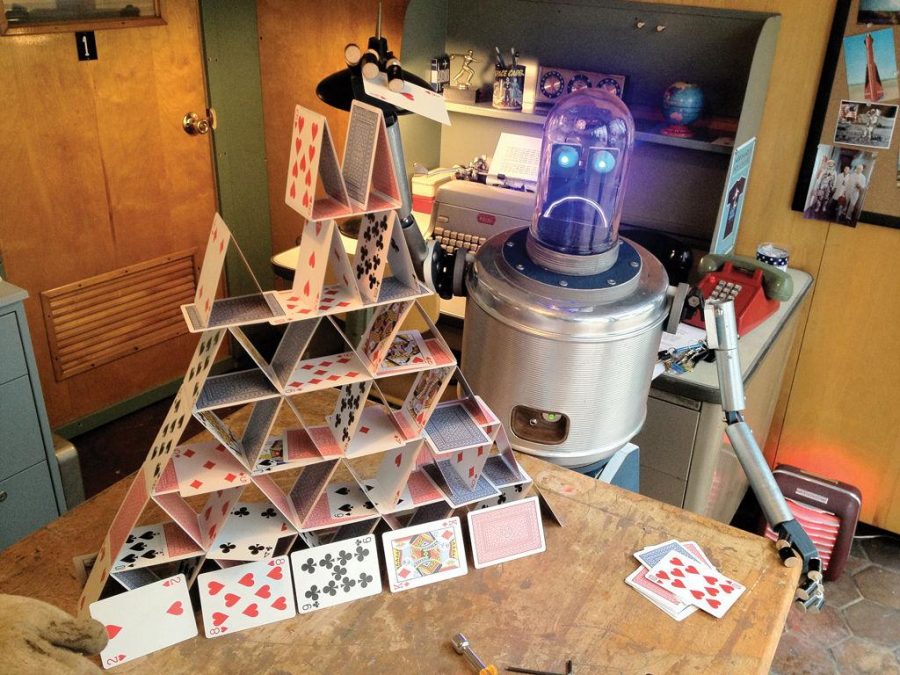Does not compute: Fraley’s Robot Repair Shop taking off at Pittsburgh International Airport
June 30, 2015
For local artist Toby Fraley, the airport was the perfect place for his latest installation.
“The long concourses stretching off into the distance, the identical rows of chairs, the magical way your bags appear in baggage claim,” Fraley said. “Being in an airport also adds a level of legitimacy to the shop [because] it’s much easier to find an empty storefront to place an installation.”
Fraley’s Robot Repair is an art installation coming to the airport in September 2015. The installation, which he designed to look like a robot repair shop, exists in a future where robot ownership is commonplace. Tools and robot parts line the walls, with an actual robot trapped inside. Fraley funded the installation after a successful online campaign through Kickstarter, on which he raised upwards of $13,800. The original goal was $10,000.
The installation originally appeared in late 2011 in a storefront on Sixth Street in the Cultural District. It remained downtown for 17 months as part of “Project Pop Up,” an initiative that aimed to fill vacant storefronts with public art, which former Mayor Luke Ravenstahl and local government agencies supported.
Fraley specializes in making interactive sculptures and public art displays. He designed Robot Repair to look like a space-age vision of the future, complete with typewriters, mid-century furniture and lots of circuit boards and wires. Every so often, he changed the position of the robot inside the display, so it looked like it was hanging holiday lights, building card houses and mailing boxes at different times.
Fraley said that as an artist, he’s drawn to the style and designs of the ‘40s through the ‘60s.
“Things back then seemed better designed, to me anyways, and often carried a nice space-age, streamlined style that translates well into being repurposed for my sculptures,” Fraley said.
He added that robots are a recurring theme in his works because they make for good storytellers.
“Humanoid-looking robots are easy to relate to. They can carry an emotion with something as simple as the position of their eyebrows,” Fraley said.
Bob Kerlik, a spokesperson for the Allegheny County Airport Authority, said Fraley will scale up the size of the installation from its original downtown iteration. He added the piece will occupy a space of about 500 square feet, which is more than three times larger than the original 160 square foot space Downtown.
“In concept, just bringing a piece to a different location is no big deal, but the square footage is why there was a Kickstarter,” Kerlik said. “[The new piece] is being tailored to be site specific.”
Kickstarter is an online fundraising platform on which artists can crowdsource funds for a project. In exchange for their contributions, artists give supporters incentives, like project-specific merchandise or chances to meet the artist.
The airport donated the space to Fraley, and Kerlik said the airport was “pleasantly surprised” at how successful the Kickstarter campaign was.
One of Fraley’s supporters and Kickstarter backers, freelance multimedia journalist Dave Cole, didn’t see the installation when it was first Downtown. But, after seeing images and testimonials online, he wanted to contribute to the project.
“It definitely seemed like a pretty awesome and genuinely creative project,” Cole said. “The Kickstarter project was particularly appealing to me since I travel often through Pittsburgh International and it would be a clever addition to the airport.”
Fraley said there were benefits to using Kickstarter to fund projects. But, he added, there were also drawbacks — Kickstarters take a lot of time and stress to run.
“An advantage to a Kickstarter project is that the public can really feel a part of [the] creation of a piece,” Fraley said. “Kickstarter does not promote your project, and promoting my own work does not come easily.”
Securing the Kickstarter funds was the last definitive step in bringing the art installation to the airport.
Kate Hansen, a project manager with the Greater Pittsburgh Arts Council, works with the airport through a partnership between the two organizations. She said the proposal to install Fraley’s Robot Repair came to the airport through a committee that reviews applications and decides if pieces would be a good fit for the airport.
“[The piece] was very popular in its Downtown version, so when we were approached, we thought that would be a great use of the space.” Hansen said. “At the airport, there’s a captive audience, because the piece will be installed airside.”
Fraley’s Robot Repair won’t be the only art display at the airport, though.
Many other pieces, like paintings and sculptures, line the airport walls, the ceilings and the floors. In October, the airport will install a terrazzo-style floor featuring different neighborhood scenes around Pittsburgh.
“There’s an Alexander Calder piece called ‘Pittsburgh’ that hangs in the airside terminal,” Hansen said, talking about the large mobile with black and white paddles that looms over the terminal.
Calder was a forerunning artist of the 20th century, known for creating the mobile, a sculpture made from delicately balanced pieces that move with motor or air power. He originally displayed “Pittsburgh” at the Carnegie Institute, but gifted it to the airport in 1959.
Unlike the other grand displays of public art in the airport, Fraley hopes for his work to blend in.
“The shop is unassuming and being tucked between actual operating stores, it could even be missed if you’re not paying attention. It’s not a traditional piece of artwork either, you really need to take a few moments and absorb what you looking at,” Fraley said. “It’s a treasure hunt that you can really get sucked into.”



